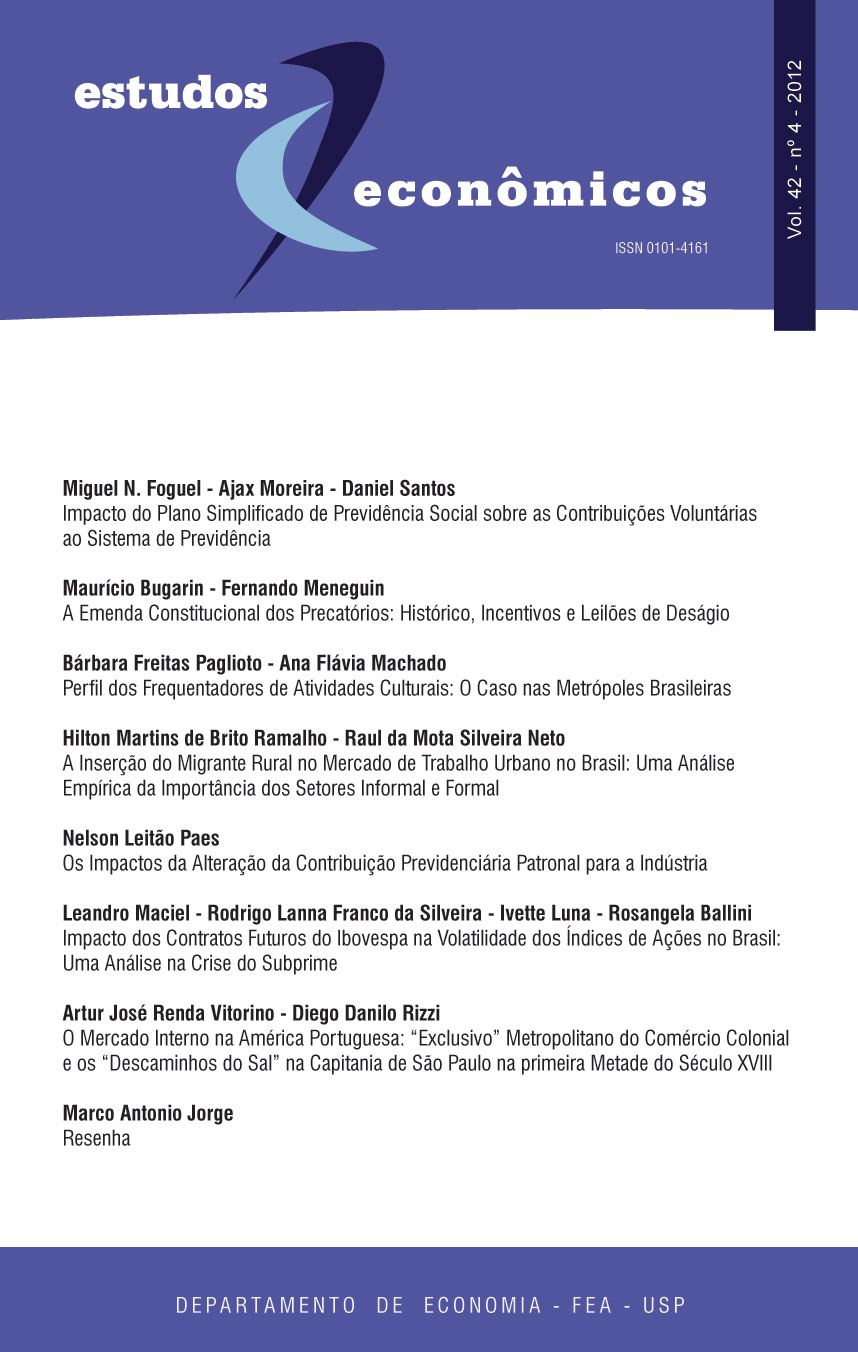The Effect of the Simplified Contribution Pension Plan on the Probability of Voluntary Contributions to the Pension System in Brazil
DOI:
https://doi.org/10.1590/S0101-41612012000400001Keywords:
pension system, self-employed, program evaluationAbstract
In April 2007 aiming at increasing participation of self-employed workers in the public pension system the Brazilian government launched the Plano Simplificado de Previdência Social (PSPS) – Simplified Pension Plan. The plan allows a reduction of the contributory percentage from 20% to 11% for any self-employed worker who decided to contribute exactly on the value of the minimum wage. Those who opt for the plan can only retire through the age criterion. The main goal of this paper was to verify whether the PSPS had an impact on the probability of voluntary contribution to the social security system of non-formal workers. To reach that goal, we use a random sample extracted from the Cadastro Nacional de Informações Sociais (CNIS) - Social Information National Register , an administrative database that contains information on the history of social security contributions of all workers. The method employed to estimate the impact was the well-known difference-in-differences approach. The results show that the PSPS seems to have increased the probability of voluntary contribution of workers whose base of contribution is the minimum wage.
Downloads
References
BERTRANOU, F. (2007) Informal Economy, Independent Workers and Social Security Coverage in Argentina, Chile and Uruguay, International Labour Office, mimeo.
BINET, G. e KULKE, U. (2006) Extension of social security to self-employed workers. OIT, mimeo.
BLUNDELL, R.; DIAS, M.C. (2000): Evaluation Methods for Non-Experimental Data, Fiscal Studies, vol. 21, n. 4, p. 427-468.
BOSCH, M. e TORNEL, M. (2011). Welfare Policies and ‘Informalization’: the Effect of Popular Insurance on Semi-Formal Firms in Mexico. Anais do XXXVI Simpósio da Associação Espanhola
de Economia.
BOSH, M. e MALONEY, W. (2005) Labor Market Dynamics in Developing Countries: Comparative Analysis using Continuous Time Processes, World Bank, mimeo.
BOSH, M. e MALONEY, W. Alternative Approaches to Evaluation in Empirical Microeconomics (2009) Journal of Human Resources, vol. 44, n. 3, p. 565-640.
CARD, D.; KRUEGER, A. B. (1994): Minimum wages and employment: a case study of the fast-food industry in New Jersey and Pennsylvania, American Economic Review, vol. 84, n. 4, p. 772-93.
CARD, D.; KRUEGER, A. B. (1995) Myth and measurement: the new economics of the minimum wage. New Jersey: Princeton University Press, 1995.
CORSEUIL, C. H.; CARNEIRO, F. G. (2001): Os impactos do salário mínimo sobre emprego e salários no Brasil: evidências a partir de dados longitudinais e séries temporais. IPEA, Texto para Discussão, n. 849.
DELGADO, G., QUERINO, A.C., CAMPOS, A., VAZ, F., RANGEL, L. e STIVALI, M. (2007): Avaliação
do Simples: Implicações à Formalização Previdenciária, Texto para Discussão 1277, IPEA.
FAJNZYLBER, P. R. (2001): Minimum wage effects throughout the wage distribution: evidence from Brazil’s formal and informal sectors. In: XXIX Encontro Nacional de Economia, Anais.
LEVY, S. (2006): “Social Policy, Productivity and Growth”, background paper para o estudo regional: Beyond Survival: Protecting Households from Health Shocks in Latin America, World Bank.
LANZILOTTA (2009). El empleo por cuenta propia y la cobertura de seguridad social en Uruguay. In: OIT: Trabajadores Independientes y protección social en America Latina, Bertranou, F. (org.), Capítulo 2.
MALONEY, W. (1999) “Does informality imply segmentation in urban labor markets? Evidence from sectoral transitions in Mexico”. World Bank Economic Review 13(2).
MEYER, B. D. (1995): Natural and quasi-experiments in economics, Journal of Business & Economic Statistics, vol. 13, n.2, p. 151-61.
NERI, M. (1998): Os empresários da Rocinha. Rio de Janeiro, mimeo.
NERI, M. et al. (2007): Em busca de incentivos para atrair o trabalhador autônomo para a Previdência Social, Nova Economia, vol. 17,n. 3, p. 363-394.
NEUMARK, D.; CUNNINGHAM, W.; SIGA, L. (2006): The effects of the minimum wage in Brazil
on the distribution of family incomes: 1996-2001, Journal of Development Economics, vol. 80,
n. 1, p. 136-159.
PUHANI, P. A. (2008): The treatment effect, the cross difference, and the interaction term in nonlinear difference-in-difference models. IZA Discussion Papers n. 3478, Institute for the Study of Labor, 2008.
ROFMAN, R.; LUCCHETTI, L. (2007): Pension Systems in Latin America: Concepts and Measurements of Coverage, Discussion Paper 616, World Bank.
RUPLEY B.B (1987): Stocastic Simulation, John Wiley & Sons.
ROBERT C.P. Casella G. (2004): Monte Carlo Statistical Methods, Springer.
VALVERDE, F. (2009). La cobertura de los trabajadores independientes en la seguridad social de Costa Rica. In: OIT: Trabajadores Independientes y protección social en America Latina, Bertranou, F. (org.), Capítulo 6.
Downloads
Published
Issue
Section
License
Copyright (c) 2012 Miguel N. Foguel, Ajax Moreira, Daniel Santos

This work is licensed under a Creative Commons Attribution-NonCommercial 4.0 International License.
By submitting an article, the author authorizes its publication and attests that it has not been submitted to any other journal. The original article is considered final. Articles selected for publication are proofread for grammatical and orthographic errors. The journal does not pay rights for published articles. The Institute of Economic Research from the School of Economics, Business and Accounting of the University of São Paulo (Instituto de Pesquisas Econômicas da Faculdade de Economia, Administração e Contabilidade da Universidade de São Paulo) owns the journal's copyright.





 Atualizado em 14/08/2025
Atualizado em 14/08/2025